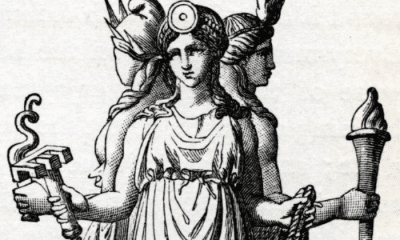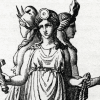Greek
What is Athena’s Symbol?
Poseidon had his trident and Zeus turned into a bull, but what were some of the attributes of Athena? Keep reading to find out about the goddess’s symbols and what they can tell us about her origins!
In ancient art, gods and heroes were often identified through the inclusion of specific symbols. Some were obvious, like the lion skin worn by Heracles, while others were more subtle or less often used.
Many of these symbols are known only to archaeologists and students of history. Others were so iconic that they are still used today to denote the same ideas the ancient gods stood for.
Some of the most enduring and visible symbols of ancient Greek religion were associated with Athena. Throughout Greece, especially in Athens, the iconography of Athena was both widespread and distinctive.
Athena is still associated with owls, but she had many other distinctive symbols as well. And these symbols of the goddess can give us clues about her pre-Greek origins.
The Symbols of Athena
In Greek art, the goddess Athena had many recognizable symbols and attributes.
Athena was the patron goddess of the city of Athens so she was often depicted there, but she was overall one of the most popular goddesses throughout the Greek world. This meant she was shown often in art, and with some regional variations.
In Athens, for example, she was often pictured with an olive tree or olive branches. This was in reference to the city’s founding myth, in which Athena gave the tree to the city to ensure its future prosperity.
Many modern viewers are most familiar with the owl as Athena’s sacred animal. The animal was so closely associated with the goddess of wisdom that it is still used as a symbol of learning today.
One of Athena’s common epithets was Glaukopis, or “Bright-Eyed,” which shares a root with the Greek word for owl. The birds were associated with Athena early on and often shown in archaic images of her.
The people of Athens eventually adopted the owl as an emblem of their city to reflect their relationship with their patron goddess. Athenian coins were known as “little owls” because they typically had the goddess’s animal on them.
Less well-remembered was the goddess’s association with snakes. Athena was often pictured with snakes along the edges of her clothing.
Of course, snakes do relate to another symbol often used in the Greek world. Athena was often pictured with the Gorgoneion – the head of Medusa.
According to legend, Athena was instrumental in helping Perseus slay the monster. After using the head to turn his own enemies to stone, the hero gifted it to Athena.
Sometimes images of Athena feature the Gorgoneion worn as an amulet, but more often it is pictured on the front of another of her famous symbols, the Aegis.
The world does not have a definite translation, but the Aegis is believed to refer to the shield Athena is generally pictured with. Possibly made of goat skins, it had first belonged to her father, Zeus, before she inherited it.
Most Greeks painted a protective charm or emblem of their patron god on their shields, both as magical protection and to instill fear in their enemies. The goddess of war decorated her own shield with the head of a vanquished foe, which itself had the power to turn her enemies to stone.
In fact, Athena’s military dress is the most distinctive attribute of the goddess in art. Even without other symbols like an owl or olives, she is easily identifiable by virtue of the fact that she is the only Olympian goddess shown with a shield and warrior’s helmet.
Athena is almost always depicted with her shield and a Corinthian-style helmet. She usually wears the helmet pushed onto the top of her head so her face is visible and often carries a spear as well.
My Modern Interpretation
Archaeologists believe that many of Athena’s defining symbols originated long before the goddess’s well-known myths were written in Greece.
Artifacts from the Mycenaean and Minoan cultures that predated archaic Greece show a female goddess with a shield, believed by many to be the precursor to Athena.
The Minoans also depicted a female deity that held snakes in her hands. The Minoan snake goddess is believed by some historians to be the origin of Athena’s association with snakes in later periods.
Some take the goddess’s roots farther back in time. The Near Eastern goddess Ishtar, also called Astarte or Inanna in some of the region’s cultures, may have provided the roots for the Mycenaean goddess with her shield.
Ishtar had many functions in the religion of ancient Near Eastern societies, one of which was as a goddess of war. Ishtar and Athena were both often seen carrying weapons and shields, unusual attributes for female deities in most cultures.
Athena’s owl may also have pre-Greek origins. There are some scholars who believe that the precursor to Athena may have been a bird goddess.
In some early art Athena is shown with wings, a convention that almost universally disappeared over time. In Homer’s Odyssey she transformed into an eagle, suggesting that she may have once been associated with birds other than her iconic owl.
The Stone Age Vinca culture of southeastern Europe, which was centered in a region just north of Greece, has provided archaeological evidence of a possible bird goddess. Several sites have contained images of a female body with the head of a bird.
Athena’s close association with owls may have grown out of this neolithic cult. Over time she lost many of her avian attributes until a single type of bird was used as a symbol separate from her own body.
Athena’s many symbols could be evidence of the fact that many local traditions were combined to create the new goddess as the Olympian religion emerged. The neolithic bird deity, Near Eastern warrior goddess, and Minoan snake figure may have all influenced the later Greek version of the goddess.
This would not have been unusual in the ancient world as migration, conquest, and trade brought different cultures into contact with one another. The practice was clearly seen in Rome for example as Greek deities, including Athena, were combined with native Latin and Eutruscan gods to create a Romanized religion.
The cultures of the Near East, in the form of the Phoenicians especially, and the Minoans are known to have had a strong presence in the lands that would later become Greece. It seems likely that they brought their own goddesses who, combined with both one another and with ancient local traditions, eventually developed into the figure we recognize as Athena.
In Summary
Athena, the Greek goddess of wisdom and war, was known by a number of attributes and symbols.
The owl is one of the most recognizable of these, and is still associated with wisdom and education today. One of Athena’s epithets is related to the Greek glaux, “little owl,” and the bird was prominently featured on Athenian coins.
Those coins also featured olive branches, a symbol of the goddess particularly in the city that was named for it. It was said that Athena won patronage of Athens by giving the people the first olive tree, so the tree symbolized her close bond with that city.
She was also associated with snakes. Athena was often shown with snakes on the edges of her clothing, or around her feet in later sculptures.
This symbol played into her role in the slaying of the Gorgon Medusa, who had snakes for hair. The Gorgon’s head was another prominent symbol of Athena, who was said to have been given it by Perseus after helping him slay the monster.
She often wore the Gorgoneion on her shield, reflecting a common Greek practice of painting protective symbols on shields. Athena’s military equipment, including the shield and the wearing of a helmet, are some of her most identifiable and unique attributes.
All of Athena’s symbols seem to have their roots in older religions. It is probable that each of these ancient traditions influenced the development of the Greek Athena.
The Near Eastern warrior goddess, Minoan snake figure, and even the prehistoric bird goddess gradually combined and evolved into the recognizable Athenian goddess. Athena’s many attributes and symbols give insight into her ancient origins.



